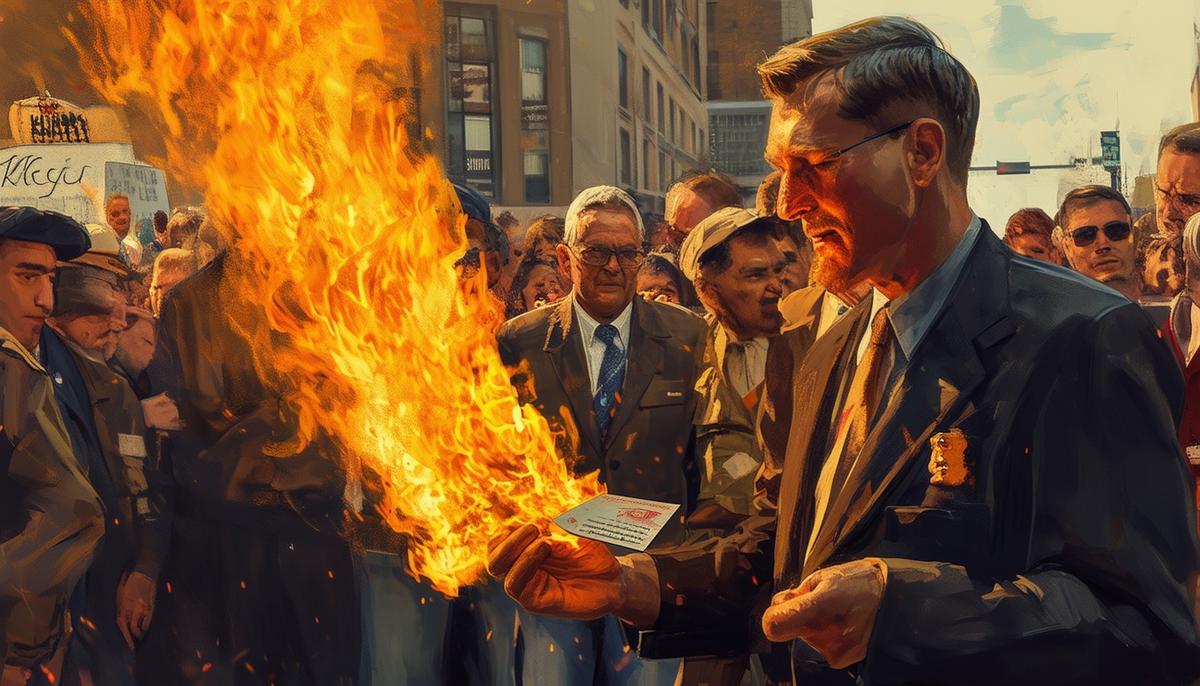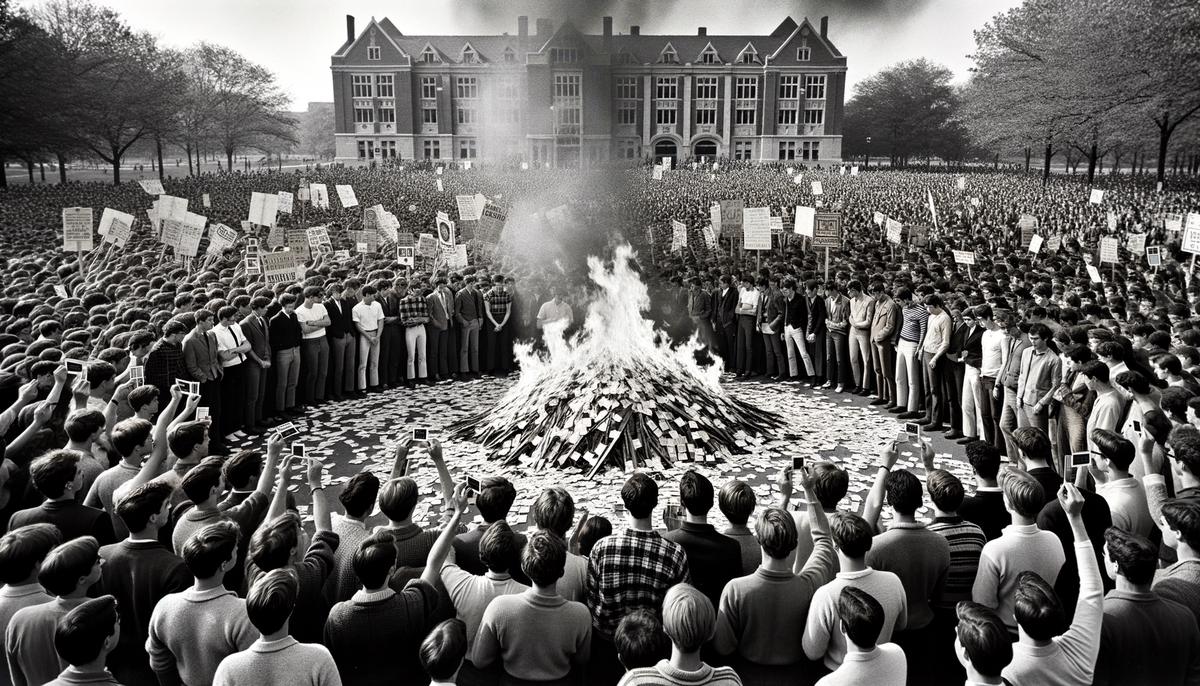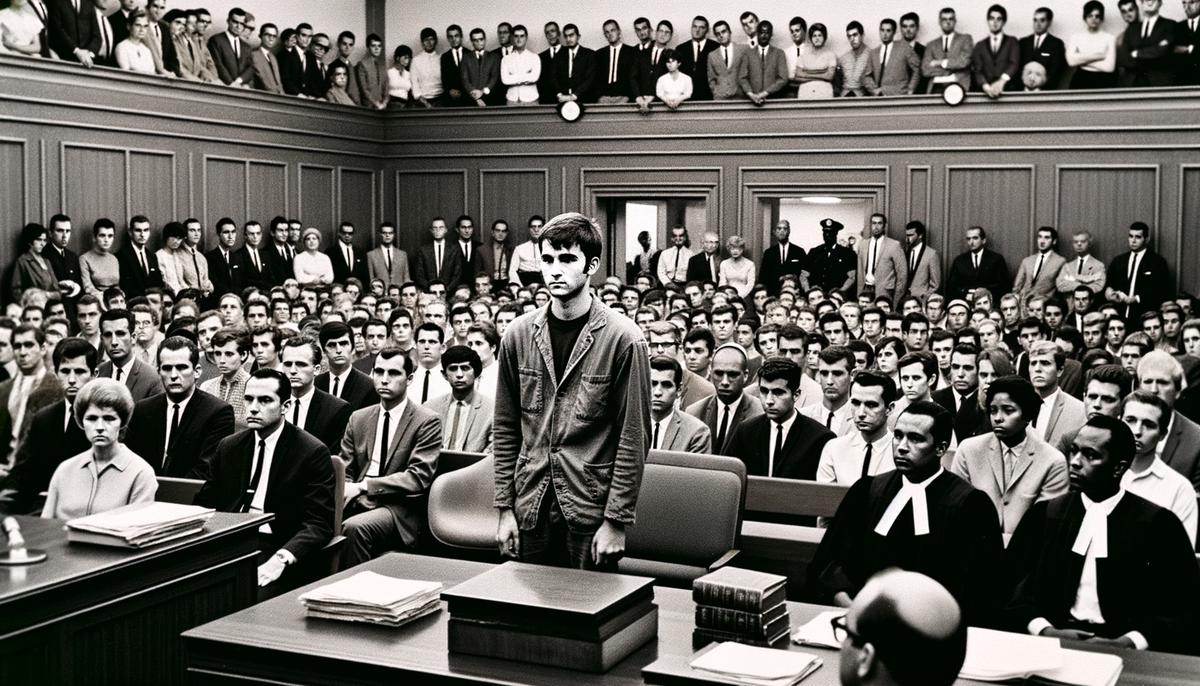Origins of Draft Card Burning
Draft card burning flared into prominence when Catholic Worker activist David Miller set his draft card ablaze on October 15, 1965. This gutsy gesture against the U.S. government's war efforts violated the law banning such acts. Miller's fiery stand earned him a collision course with the FBI, a guilty verdict, and two years in the slammer.
Miller's act sparked others into action. That same day, the National Coordinating Committee to End the War in Vietnam rallied in 40 cities, drawing 100,000 people to the streets. Draft card burning became a uniquely American symbol of protest—a flaming shout for peace and justice.
As antiwar sentiment bubbled up, more folks were drawn to the blaze of protest fires. Headlines screamed, cops scrambled, and society sat up straight. Youths across the nation chimed in with their own fiery protests. The burning of draft cards spread across the land, turning city squares into stages for civil disobedience.
The legal stakes were high, with each act risking jail time. But jail didn't scare these protesters; it merely fueled them further. Set to a soundtrack of protest songs, the movement gained rhythm and momentum. Draft cards became a calling card for change, a flammable message shining brightly in the story of resistance.

Impact of Draft Card Burning
Burning draft cards became the soul of a generation's fight against the powers that be. These paper infernos served as a rallying cry that echoed through America and beyond, bridging the gap between dissent and a full-throttle antiwar movement.
Each burn was a powerful visual metaphor for rejecting a war many saw as unjust. The crackle of burning cards echoed within the halls of power, whispering change. Public opinion, already simmering with doubt about the war, was ignited in a wildfire of sentiment and protest.
The impact was electric—the shift from silent acceptance to vocal, visible defiance signified a cultural earthquake. University campuses became hotbeds of activism, filled with fervent speeches and burning cards. This flickering flame of rebellion ignited a broader coalition of people who had previously sat on the sidelines.
Through every singed corner and charred edge, a message was sent—peace was not just preferred, it was demanded. With each card aflame, the movement burned brighter into the annals of history, a testament to the relentless pursuit of change.

Legal and Social Consequences
The fallout from draft card burning wasn't all peace and love—there were serious consequences for those bold enough to light up. Under federal law, it was an offense that could saddle you with a hefty fine or even jail time. David Miller, our trailblazing firestarter, found this out when the FBI came calling and he was sentenced to two years in the slammer.
For many, the call of the fire was louder than the fear of handcuffs. Arrests and trials became almost commonplace, with each courtroom serving as a new stage for protesters to make their stand. In those halls, they weren't just on trial for burning cards; they were challenging the morality of a war.
Public opinion was split. Some viewed these protesters as reckless hooligans, unpatriotic or morally bankrupt. But there was also a chorus of support—scholars, artists, and everyday folks who resonated with their cries for peace stood in solidarity.
"Never before had so many demonstrated their hope for peace."– Walter Cronkite, on the National Moratorium protests
Although the law handed down penalties, the burgeoning support said it all: these fiery acts had lit a torch in the collective consciousness. Even in the smoldering aftermath, the spirit of resistance remained untamed, a rebellious flame refusing to be doused.

Draft Evasion Tactics
During the Vietnam era, young men dodged the draft with a menu of creative strategies. Some enlisted in other branches like the Air Force, Navy, or Coast Guard, which had stricter standards but were seen as cushier rides.
Conscientious objectors claimed that serving went against their deepest convictions. After the Welsh v. United States decision in 1970 widened the definition, many nabbed that deferment card with help from organizations like the American Friends Service Committee.
Before August 26, 1965, getting hitched meant dodging the draft. After that, parenthood became the golden ticket, sparking a mini baby boom among draft-dodging couples.
Common Draft Evasion Tactics:
- Enrolling in college (student deferments)
- Claiming medical exemptions (4-F designation)
- Fleeing to Canada or Sweden
- Joining alternative military branches
- Becoming a conscientious objector
Through all these musical chairs of draft evasion, a portrait of resistance emerged, weaving boots, books, beliefs, and banners into a multifaceted image of a generation not content to march to someone else's drum.
Draft card burning during the Vietnam War era was a powerful symbol of defiance and a call for change. This fiery protest challenged the status quo and united a generation in their pursuit of peace. The flames of resistance burned brightly, leaving an indelible mark on history and reminding us that the fight for justice can ignite from the smallest spark.
- Foner P. U.S. Labor and the Vietnam War. International Publishers; 1989.
- Rutenberg A. Rough Draft: Cold War Military Manpower Policy and the Origins of Vietnam-Era Draft Resistance. Cornell University Press; 2019.
